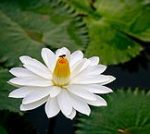 Also known as tiger lotus, Egyptian white water lily, and white lotus, this aquatic fresh water perennial is a member of the water lily family, Nymphaceae, a small family of 3-6 genera. It is native to east Africa and southeast Asia where it grows in clear, warm, still, slightly acidic waters. Growing 8-18″ tall from a rhizomatous root system it has large round leaves that are up to 12″ across and float on the surface of the water. The mature leaves are peltate, softly hairy below, and have spiny, toothed margins. The flowers appear all summer, are 5-10″ across, and consists of a center of golden stamens surrounded by conspicuously veined sepals and pointed petals that are white, sometime tinged with pink. They open at night, close by late morning, and are held up to 8″ above the surface of the water. The white Egyptian lotus was used by the Egyptians for perfume, funerary garlands, temple offerings, and as personal and garden adornments. It may have been the lotus mentioned in Homer’s Odysseys. Plants have medicinal properties and all parts of the plant are edible. The plant can become invasive in the rice fields of modern Egypt. The genus name, Nymphaea, comes from the Greek word numphaios and means sacred to the nymphs. The specific epithet, lotus, is from the Greek word lōtos, used to denote certain plants.
Also known as tiger lotus, Egyptian white water lily, and white lotus, this aquatic fresh water perennial is a member of the water lily family, Nymphaceae, a small family of 3-6 genera. It is native to east Africa and southeast Asia where it grows in clear, warm, still, slightly acidic waters. Growing 8-18″ tall from a rhizomatous root system it has large round leaves that are up to 12″ across and float on the surface of the water. The mature leaves are peltate, softly hairy below, and have spiny, toothed margins. The flowers appear all summer, are 5-10″ across, and consists of a center of golden stamens surrounded by conspicuously veined sepals and pointed petals that are white, sometime tinged with pink. They open at night, close by late morning, and are held up to 8″ above the surface of the water. The white Egyptian lotus was used by the Egyptians for perfume, funerary garlands, temple offerings, and as personal and garden adornments. It may have been the lotus mentioned in Homer’s Odysseys. Plants have medicinal properties and all parts of the plant are edible. The plant can become invasive in the rice fields of modern Egypt. The genus name, Nymphaea, comes from the Greek word numphaios and means sacred to the nymphs. The specific epithet, lotus, is from the Greek word lōtos, used to denote certain plants.
Type: Aquatic perennial
Bloom: White flowers 5-10″ across held above the water, opening at night until late morning, in summer
Size: 8-10″
Light: Full sun
Soil: Undisturbed fresh water, slightly acidic soil
Hardiness: Zones 10-12
Care: Fertilize with aqautic fertilizer every 2-3 weeks; protect from wind.
Pests and Diseases: Aphids, midges, China mark moth, crown rot
Propagation: Seed, division of rhizome
Companion Plants: Blue lotus, water hyacinth, water lettuce
Photo Credit: Wikipedia